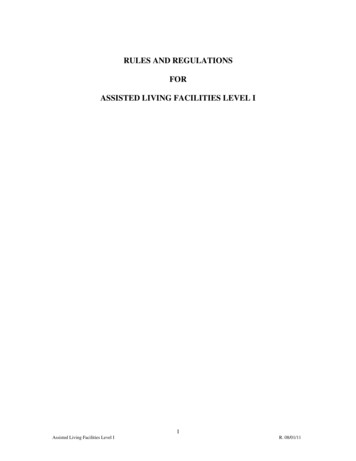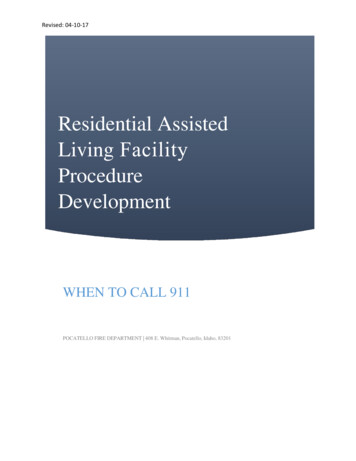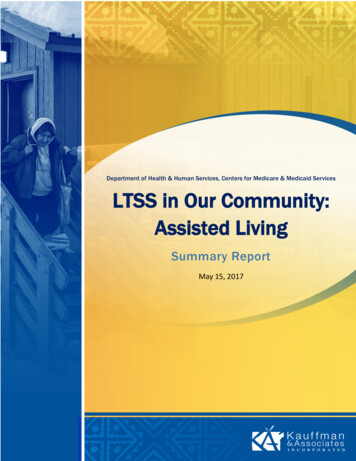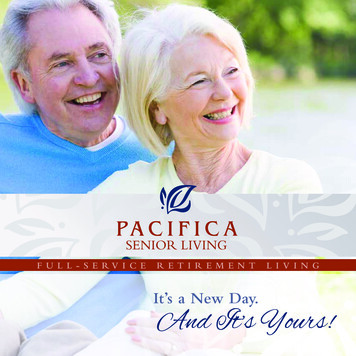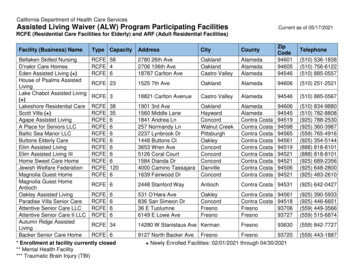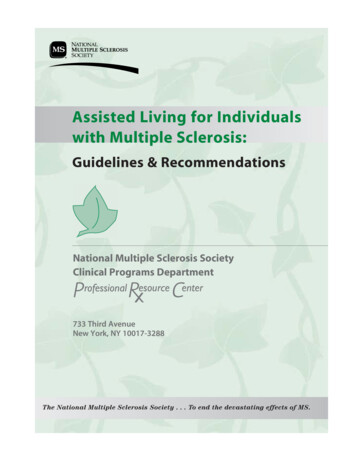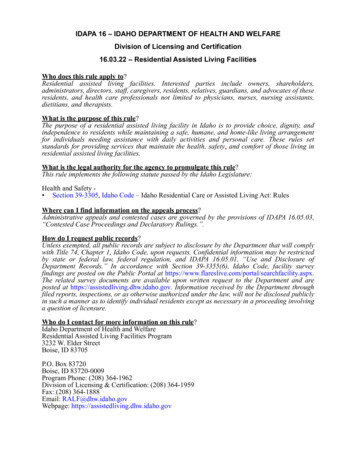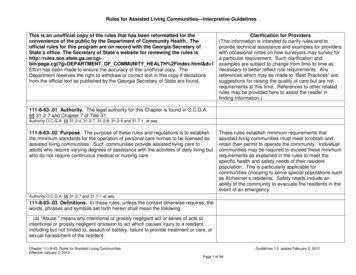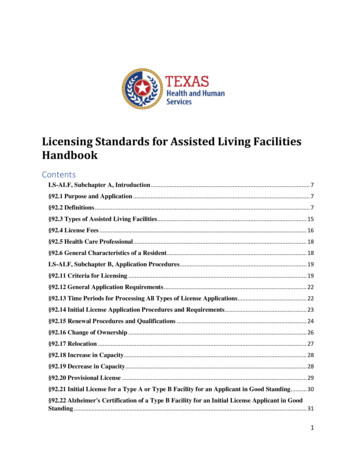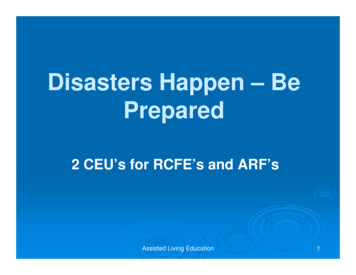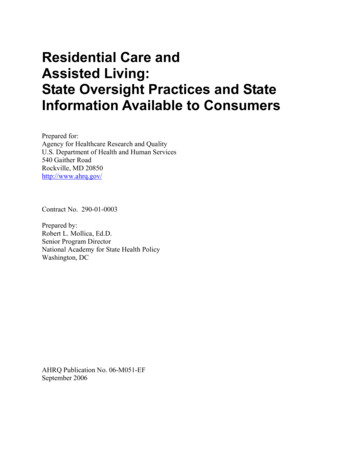
Transcription
Residential Care andAssisted Living:State Oversight Practices and StateInformation Available to ConsumersPrepared for:Agency for Healthcare Research and QualityU.S. Department of Health and Human Services540 Gaither RoadRockville, MD 20850http://www.ahrq.gov/Contract No. 290-01-0003Prepared by:Robert L. Mollica, Ed.D.Senior Program DirectorNational Academy for State Health PolicyWashington, DCAHRQ Publication No. 06-M051-EFSeptember 2006
This document is in the public domain and may be used and reprinted withoutpermission.Suggested citation:Mollica RL. Residential Care and Assisted Living: State Oversight Practices and StateInformation Available to Consumers. AHRQ Publication No. 06-M051-EF. Rockville,MD: Agency for Healthcare Research and Quality. September 2006.This report was prepared for the Agency for HealthcareResearch and Quality by the National Academy for StatePolicy. The information and recommendations presented inthis report do not necessarily represent the view of AHRQ. Noii
ContentsExecutive Summary . 1Section I. Introduction and Overview . 3Introduction .3Overview.3Facing the Information Challenge .4Communicating with Consumers .6State Licensing Agencies .6State Units on Aging .7Comparing, Rating, and Profiling Facilities .13Using the Internet .17Facility Lists .18Survey and Complaint Findings .18Examples of State Web Sites .18Consumer Guides and Disclosure Statements .20Oversight Process .26Innovations in the Oversight Process .27Supporting Quality Through Technical Assistance .29Discussion .30Section II. Consumer Guides to Assisted Living . 33Section III. State Summaries . 61Alabama .61Alaska .62Arizona .62Arkansas .63California .64Colorado .65Connecticut .66District of Columbia .67Delaware .67Florida .68Georgia .70Hawaii .70Idaho .71Illinois .72Indiana .73Iowa .74Kansas .75Kentucky .75Louisiana .76iii
Maine 76Maryland .77Massachusetts .78Michigan .79Minnesota .80Mississippi .81Missouri .81Montana .82Nebraska .83Nevada .84New Hampshire .85New Jersey .86New Mexico .87New York .88North Carolina .89North Dakota .90Ohio .91Oklahoma .91Oregon .92Pennsylvania .92Rhode Island .93South Carolina .94South Dakota .95Tennessee .96Texas .97Utah .97Vermont .98Virginia .98Washington .99West Virginia .100Wisconsin .101Wyoming .101iv
Executive SummaryThis report was commissioned by the Agency for Healthcare Research and Quality through asubcontract with Westat to review: State monitoring and oversight practices of assisted living facilities.Information that is available on State agency Web sites to consumers and family membersabout assisted living.1State monitoring and oversight practices of assisted living are similar to, although not asextensive as, those used by States to review nursing homes. Assisted living monitoring andsurvey tools track each State’s own regulatory requirements and are not standardized acrossStates. A review of the Web sites of State licensing agencies found that 48 States post licensingregulations; 46 provide access to a database or list of licensed facilities; 12 post survey findingson their Web site; and 14 States post a guide to help consumers and family members learn aboutand choose a facility. Twenty-six States offer information to facility administrators and staff on aWeb site. The information ranges from licensing application and renewal forms, administratorrequirements, bulletins, information about the survey process, technical assistance materials, andincident and complaint forms.Twenty-six State Units on Aging (SUAs) post information about assisted living on their Websites. A few SUAs link to information available on the licensing agency’s site, but mostsupplement what is available on other sites.One purpose of this project was to assess the interest among State agencies in ways to helpconsumers compare facilities. Rating or profiling of facilities requires sources of information thatare standardized and contain sufficient data to allow consumers to determine how a specificfacility compares to other facilities or where it falls along a continuum. Types of data mightinclude survey findings, resident functional and health information, or outcomes data.A small number of States are actively developing a system to rate or profile assisted livingsettings, although some other States are interested in developing a rating system. Unlike nursinghomes, most States do not require the reporting of assessment data that are needed to establishoutcomes that can be tracked and compared with other facilities. Facility performanceinformation can be obtained from survey reports and complaint investigations, but thisinformation is not automated or published in most States. State contacts noted that budgettightening has left many agencies with limited staff, and their primary priority is to monitorquality and program compliance.1Assisted living also includes residential settings that may be licensed as residential care homes, personal carehomes, adult homes, and other types of facilities. See the overview section of this report for additional information.1
2
Section 1. Introduction and OverviewIntroductionAssisted living has grown rapidly as an important source of services in residential settings forolder people. Because of this rapid growth and differences among States in how assisted living isdefined and licensed, and even what it is called, older people and families need information tounderstand what assisted living is, how it may meet their needs, and how to choose a facility.This report was commissioned by the Agency for Healthcare Quality and Research to describethe extent of information that is available to consumers and families from State agencies and todescribe State oversight policies and practices. The report was prepared by the NationalAcademy for State Health Policy under a subcontract with Westat.Information for the report was collected in 2005 through telephone interviews with key contactsin State licensing agencies, a review of the licensing regulations in each State, and a search of theWeb site for each State licensing agency and State Unit on Aging (SUA). The telephoneinterviews with State licensing agency contacts were unstructured discussions of the State’sapproach to oversight, the survey process, methods of obtaining information from residents andstaff about the services provided, information about the survey findings that is available toconsumers, information available on the agency’s Web site, and the agency’s interest indeveloping a method to rate or profile facilities. Web sites change frequently and may not becurrent. The links were active as of November 2005. In addition, in any given year about half ofthe States make minor to major changes in their licensing rules, and the information posted onthe Web sites may not always reflect current policy or information.Section I of the report describes the primary findings. Section II contains information abstractedfrom consumer guides that are available from the Web sites of State agencies. Section IIIincludes brief summaries of each State’s approach to regulating assisted living and theinformation that is available on the State agency Web sites.OverviewAssisted living has emerged as a popular choice for people who need supportive and healthrelated services and help with unscheduled activities of daily living. Simply understandingassisted living can be confusing because there is no universal (or Federal) definition of the term,and there is no standard definition or term used by all States. The term assisted living is used in41 States, but similar facilities may be licensed by States as personal care homes, residential carefacilities, adult care homes, homes for the aged, and other types of facilities. The services andlevel of care available also vary by State and within States. State regulations generally describethe parameters of the people who may be served and the services that may be offered, butfacilities often set their threshold below what may be allowed by the regulations.3
For the purposes of this study, assisted living is a generic term that refers to facilities, buildings,or residences that are licensed by States to provide support and personal care services toindividuals who are not related to the owner.The supply of licensed units grew from about 612,000 in 1998 to 937,601 in 2004. However, therate of growth slowed from 13 percent between 2000 and 2002 to 3 percent between 2002 and2004.2 State licensing officials believe there is excess supply in many areas of their States, andthat the growth rate has declined because of competition and pressure on occupancy rates.Because of its growth and the increasing needs of people who move to assisted living facilities,State oversight staff, policymakers, legislators, advocates, family members, consumers, andFederal agencies are interested in the oversight of facilities and the quality of care delivered toresidents.Facing the Information ChallengeDespite widespread use of the term, assisted living has evolved as a generic term that describesservices in licensed residential settings. Some States have separate licensing categories andrequirements for assisted living and residential care facilities; others use the termsinterchangeably. Definitions of assisted living include references to the licensed entity, the typeof building, the relationship of the residents to the owner, the purpose for which a license issought, the philosophy of the regulations, the needs that may be addressed or not addressed, theservices that may or may not be provided, and the minimum size required for license.The widespread use of the term assisted living and the considerable State variability in itsdefinition continue to fuel debate about what assisted living is and should be, how it should beregulated (particularly as the number of residents with higher levels of need increases), andwhether facilities that do not support key assisted living principles should use the term.When the term was first used, State officials and others believed it reflected a new philosophy.Regulations were developed based on consumer choice, independence, dignity, and privacy.Licensing rules sometimes referred to “residences” rather than “facilities” to differentiate themfrom older, more institutional settings. Private apartments or rooms with attached baths replacedshared rooms and bathing facilities. Assisted living in Oregon, one of the first States to use theterm, “means a building, complex or distinct part thereof, consisting of fully self-containedindividual living units where six or more senior and persons with disabilities may reside. Thefacility offers and coordinates a range of supportive personal services available on a 24-hourbasis to meet the activities of daily living (ADLs), health services, and social needs of theresidents described in these rules. A program approach is used to promote resident self-directionand participation in decisions that emphasize choice, dignity, privacy, individuality,independence and home-like surroundings.”States creating a new category called assisted living retained existing categories andrequirements for other residential care settings. Over time, more States adopted the term to2Robert Mollica and Heather Johnson-Lamarche. Residential Care and Assisted Living Compendium 2004. U.S.Department of Health and Human Services, Office of the Assistant Secretary for Planning and Evaluation. March2005. Available at: http://aspe.hhs.gov/daltcp/reports/04alcom.htm. Accessed August 17, 2006.4
reflect its emerging appeal, but assumptions about assisted living—assumptions shared by manyconsumers and researchers—often were not adopted. Several types of regulations emerged.Some were institutional while others reflected a new approach, and two States focused onlicensing the provider of services rather than the setting or building.3 Generic use of the termassisted living obscures the difference between types of residential care settings and makes itdifficult for consumers to determine which setting will best meet their current and future needs.Because there is no common definition of assisted living, consumers and family members facereal challenges when they seek information about this residential option. A 1999 report by theGovernment Accountability Office (GAO), formerly the General Accounting Office, noted thatconsumers need “clear and complete information” about the services provided by individualassisted living residences and the cost of those services.4 In most States, essential information isavailable directly from the facilities. Several national and State organizations have developedchecklists or guidelines to help consumers obtain information and compare residences. Morerecently, State agencies have developed Web sites to assist consumers. Most of these sites allowconsumers to search for residences and list the name of the residence, address, phone number,and administrator. A few include survey findings and complaints.The GAO report found that prospective residents obtain information from written materials,tours, personal interviews, and recommendations from friends. The report noted that mostresidents received assistance from a family member, friends, or health professionals to help maketheir decision.In 2004, GAO was asked to review State initiatives that address issues faced by consumers andproviders. The study focused on three areas: disclosure, State efforts to help providers meetminimum standards, and complaint procedures.5 The study examined initiatives in Florida andTexas to provide information to consumers, use of remedies to improve compliance in Georgia,consultation from the licensing agency in Washington, and an ombudsman program inMassachusetts.The U.S. Senate Aging Committee held a hearing in 2000 to discuss the issues described in aGAO report including the lack of a common definition of assisted living and resulting consumerconfusion about this residential option. The Committee suggested that industry and other keystakeholders form an Assisted Living Workgroup (ALW) to review key issues and makerecommendations that would improve quality and lead to a common definition. The workgroupincluded over 50 organizations with a variety of interests including industry associations,professional organizations, consumer and advocacy groups, and State officials.The ALW presented its recommendations to the Senate Aging Committee at a hearing in April2003. Most of the informational issues affecting consumers were addressed under3See Robert Mollica. State Assisted Living Policy: 1998 and State Assisted Living Policy: 2000. National Academyfor State Health Policy. Portland, ME.4Government Accountability Office. Assisted Living: Quality of Care and Consumer Protection Issues in FourStates. GAO/HEHS-99-27. Washington, DC. April 1999.5Government Accountability Office. Assisted Living: Examples of State Efforts to Improve Consumer Protections.GAO-04-684. Washington, DC. April 2004.5
recommendations related to resident rights. The recommendations generally require thatinformation made available to consumers be understandable, consistent with written contracts,and complete.Information on assisted living is available electronically from multiple sources. An Internetsearch identifies national and State provider associations, provider Web sites, directories, andreferral services from for-profit organizations, consumer advocacy organizations, marketing andconsulting firms, the Administration on Aging, and State agency Web sites. Information mayalso be obtained from State departments, divisions, or bureaus on aging; area agencies on aging;government consumer information agencies; and other county or local agencies.Information about assisted living is also available from the U.S. Department of Health andHuman Services’ Administration on Aging (AoA), under the “elders and families” and “housingservices” section of the Web site. Visitors to the Web site will find a description of assistedliving and the kind of residents who live in assisted living facilities. The Web site presents a briefchecklist that can be used to evaluate a facility’s characteristics and a list of other consumer andprovider-based organizations that offer additional information.6Communicating with ConsumersThere are many sources of information about assisted living. This report describes informationavailable from State agencies. States are responsible for licensing facilities and providingoversight to monitor quality of care and compliance with statutory and regulatory requirements.Information for consumers and families is primarily available from agencies that are responsiblefor issuing regulations and licensing and monitoring facilities and agencies that serve olderadults (see Tables 1 and 2).State Licensing AgenciesState licensing agencies use the Internet and their Web sites to communicate information toconsumers and family members about assisted living. The project identified several types ofinformation posted on State licensing agency Web sites about assisted living. A review oflicensing agency Web sites identified information that is useful to consumers and owners,operators, and developers of assisted living facilities (see Table 1.) Some of the informationposted is directed toward consumers and family members. Other information—such asregulations, survey guidelines, and incident reporting forms—is primarily directed towardowners and operators, but it is also available to consumers and family members who areinterested.State Web sites most commonly post the regulations used to license and survey facilities. Fortyeight States post links to their licensing regulations and statutes. Links to State licensingregulations are generally available on the Web site of the licensing agency. However, someregulations can be found on Web sites hosted by the Office of the Secretary of State or the Statelegislature.6Available at: http://www.aoa.gov/eldfam/Housing/Housing Services/HH Assisted Living.asp. Accessed August18, 2006.6
Twenty-six States post additional information primarily for facility owners, administrators, andmanagers. Provider information includes documents relating to the survey process, guidelinesand requirements, training, background checks, various forms, and notices.Forty-two States post lists of licensed facilities. The information may be posted as a searchabledatabase or a simple file listing the name of the facility, address, and phone number. FourteenStates post a consumer guide or a list of questions to ask on their Web site. Guide means aresource to help consumers and families understand assisted living and compare and select afacility.Twelve States include information from survey reports and complaint investigations. Surveyreports are prepared by State monitoring staff following on-site visits to assess compliance withState licensing requirements.State Units on AgingAll States operate programs and services for older adults under the Older Americans Act. Stateagencies responsible for these activities may be an executive office, department, division,bureau, or commission and are generally referred to as State Units on Aging (SUAs). Some arecabinet level agencies; most are units within a larger umbrella agency or department. SomeSUAs are also responsible for Medicaid home and community-based waiver services programsand State general revenue home care programs. Some aging agencies serve only older adults(ages 60 or 65 and older), while others also serve adults with physical disabilities and/orindividuals with developmental disabilities.SUAs are an important source of information for older adults and families about long-term careservices, including assisted living options. SUAs have a broader mission than licensing agenciesand are charged under the Older Americans Act with a broad range of services to older adults,including services “designed to encourage and assist older individuals to use the facilities andservices (including information and assistance services) available to them.”7 Web sites typicallyinclude information about the services and resources available through SUAs, as well as generalinformation about Medicare and resources available through Area Agencies on Aging. ThirtySUA Web sites contained information or links to information about assisted living (see Table3.)8 Eight of the SUAs are also responsible for licensing or certifying assisted living facilities.A few SUAs have links to Web sites maintained by groups outside of State government. TheNebraska Department of Health and Human Services and the State’s SUA link to a non-profitorganization, Answers4Families, which is a project of the Center on Children, Families, and theLaw at the University of Nebraska. It was formed to “provide information, opportunities fordialogue, education, and support to Nebraskans with special needs and their families bydeveloping and providing Internet resources”9 and is supported by funding from the NebraskaAging and Disability Services and other State agencies. The site includes a guide to assisted7Older Americans Act. 42 USC Section 3030D.Although they were not part of this review, Area Agencies on Aging may also have information for consumersabout assisted living.9Available at: www.answers4families.org. Accessed August 17, 2006.87
living, a link to a list of facilities on the licensing agency’s Web site, information about coverageof assisted living
Assisted living has emerged as a popular choice for people who need supportive and health-related services and help with unscheduled activities of daily living. Simply understanding assisted living can be confusing because there is no universal (or Federal) definition of the term, and th
